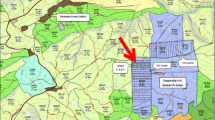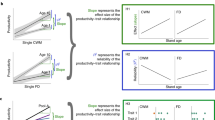Abstract
Data from 122 northeastern Ontario plots were used to develop composite site-productivity functions for black spruce (Picea mariana [Mill.] B.S.P.). A logistic model produced the best fit to the data. The resulting equations produce sets of polymorphic site-productivity curves with subsets of three curves, one for each of Ontario's Forest Ecosystem Classification Operational Groups (FEC OGs) 11, 12 and 14. For direct estimates of site productivity, site index was expressed as a function of stand height, age and FEC OG by employing the reciprocal of the logistic model. Application of the resulting equations and tables is demonstrated in an example. The procedures employed may be used to develop ecologically based site-productivity functions for other areas.
Similar content being viewed by others
References
Alban, D. H. 1979. Estimating site potential from the early height growth of red pine in the Lake States. USDA For. Serv., North Central For. Exp. Stn., St. Paul, Minn. Res. Pap. NC-166. 7 pp.
Cajander, A. K. 1926. The theory of forest types. Acta For. Fenn. 29.
Carmean, W. H. 1975. Forest site quality evaluation in the United States. Adv. Agron. 27: 209–269.
Carmean, W. H. 1979. Site index comparison among northern hardwoods in northern Wisconsin and upper Michigan. USDA For. Serv., North Central For. Exp. Stn., St. Paul, Minn. Res. Pap. NC-169. 17 pp.
Carmean, W. H. and Hahn, J. T. 1981. Revised site index curves for balsam fir and white spruce in the Lake States. USDA For. Serv., North Central For. Exp. Stn., St. Paul, Minn. Res. Note NC-269. 4 pp.
Coile, T. S. 1948. Relations of soil characteristics to site index of loblolly and short leaf pines in the upper Piedmont Region of North Carolina. Duke Univ., Sch. For. Bull. 13.
Coile, T. S. 1952. Soil and the growth of forests. Adv. Agron. 4: 329–398.
Daubenmire, R. F. and Daubenmire, J. B. 1968. Forest vegetation of eastern Washington and northern Idaho. USDA, Wash. Agric. Exp. Stn. Tech. Bull. 60.
Day, M. W., Bey, C. F. and Rudolph, V. J. 1960. Site index for planted red pine by the 5-year growth intercept method. J. For. 58: 198–202.
Ek, A. R. 1971. A formula for white spruce site index curves. Univ. Wisc. For. Res. Note No. 161. 2 pp.
Grigal, D. F. 1984. Shortcomings of soil surveys for forest management. pp. 148–166. In: Bockheim, J. G. (Ed) Proc. Symp. on Forest Land Classification: Experiences, Problems, Perspectives. USDA For. Serv., North Central For. Exp. Stn., St. Paul, Minn. Rep. NCR-102. 209 pp.
Hills, G. A. 1955. Field methods for investigating site. Ont. Dep. Lands For., Toronto, Ont. Site Res. Man. 4. 120 pp.
Hodgkins, E. J. 1970. Productivity estimation by means of plant indicators in the longleaf pine forests of Alabama, pp. 128–132. In: Youngberg, C. T. and Davey, B. (Eds) Tree Growth and Forest Soils. Oregon State Univ. Press, Corvallis.
Jeglum, J. K., Arnup, R., Jones, R. K., Pierpoint, G. and Wickware, G. M. 1983. Forest ecosystem classification in Ontario's Clay Belt: a case study, pp. 111–127. In: Mroz, G. D. and Berner, J. F. (Eds) Proc. Artificial Regeneration of Conifers in the Upper Great Lakes Region. Mich. Tech. Univ., Houghton, Mich.
Jones, R. K., Pierpoint, G., Wickware, G. M., Jeglum, J. K., Arnup, R. W. and Bowles, J. M. 1983. Field guide to forest ecosystem classification for the Clay Belt, Site Region 3E. Ont. Min. Nat. Resour., Toronto, Ont. Misc. Publ., 123 pp.
LeBlanc, P. A. and Towill, W. D. 1989a. Can jack pine site productivity in north-central Ontario be predicted using multiple regression soil-site equations? Ont. Min. Nat. Resour., Tech. Rep. No. 33, 14 pp.
LeBlanc, P. A. 1989b. Can we use northern prime land classification to identify the productivity of jack pine sites in north-central Ontario? Ont. Min. Nat. Resour., Northwestern Ont. For. Tech. Devel. Unit, Tech. Rep. No. 34, 21 pp.
Lewis, N. B., Keraus, A. and Leech, J. W. 1976. Yield regulation in south Australian Pinus radiata plantations. South Australia Woods For. Dep., Bull. No. 23.
Lundgren, A. L. and Dolid, W. A. 1970. Biological growth functions describing published site index curves for Lake States timber species. USDA For. Serv., North Central For. Exp. Stn., St. Paul, Minn. Res. Pap. NC-36, 9 pp.
Monserud, R. A. 1984a. Height growth and site index curves for Douglas fir based on stem analysis and forest habitat types. For. Sci. 30(4): 943–965.
Monserud, R. A. 1984b. Problems with site index: an opinionated review, pp. 167–180. In: Bockheim, J. G. (Ed) Proc. Symp. on Forest Land Classification: Experiences, Problems, Perspectives. USDA For. Serv., North Central For. Exp. Stn., St. Paul, Minn. NC-102. 209 pp.
Monserud, R. A. 1987. Variation on a theme of site index, pp. 419–427. In: Ek, A. R., Shifley, S. R. and Burk, T. E. (Eds) Proc. IUFRO Forest Growth Modeling and Prediction Conference, Minneapolis, Minn. 23–27 August 1987. USDA For. Serv., North Central For. Exp. Stn., St. Paul, Minn. Gen. Tech. Rep. NC-120.
Monserud, R. A., Moody, U. and Breuer, D. 1990. A soil-site study for inland Douglas-fir. Can. J. For. Res. 20(6): 686–695.
Newnham, R. M. 1988. A modification of the Ek, Payandeh nonlinear regression model for site index curves. Can. J. For. Res. 18(1): 115–120.
Olson, D. F. and Della-Bianka, L. 1959. Site index comparison for several tree species in the Virginia-Carolina Piedmont. USDA For. Serv., Southeastern For. Exp. Stn., Upper Darby, Penn., Res. Pap. 104.
Payandeh, B. 1977. Metric site index formulae for major Canadian timber species. Dep. Environ., Can. For. Serv., Bi-monthly Res. Notes 33(5): 37–39.
Payandeh, B. 1978. A site index formula for peatland black spruce in northern Ontario. For. Chron. 54(1): 39–41.
Payandeh, B. 1986. Predictability of site index from soil factors and lesser vegetation in northern Ontario forest types. Gov't of Can., Can. For. Serv., Sault Ste. Marie, Ont. Inf. Rep. O-X-373. 12 pp. plus appendices.
Plonski, W. L. 1956. Normal yield tables for black spruce, jack pine, aspen and white birch in Ontario. Ont. Dep. Lands For., Timber Manage. Div., Toronto, Ont. Rep. 24. 40 pp.
Payandeh, B. 1977. A site index formula for peatland black spruce in northern Ontario. For. Chron. 54(1): 39–41.
Payandeh, B. 1986. Predictability of site index from soil factors and lesser vegetation in northern Ontario forest types. Gov't of Can., Can. For. Serv., Sault Ste. Marie, Ont. Inf. Rep. O-X-373. 12 pp. plus appendices.
Plonsk, W. L. 1956. Normal yield tables for black spruce, jack pine, aspen and white birch in Ontario. Ont. Dep. Lands For., Timber Manage. Div., Toronto, Ont. Rep. 24. 40 pp.
Richards, F. J. 1959. A flexible growth function for empirical use. J. Exp. Bot. 10(29): 290–300.
Schmidt, M. G. and Carmean, W. H. 1988. Jack pine site quality in relation to soil and topography in north central Ontario. Can. J. For. Res. 18(3): 297–305.
Stage, A. R. 1963. A mathematical approach to polymorphic site index curves for grand fir. For. Sci. 9: 167–180.
Thrower, J. S. (1987). Growth intercepts for estimating site quality of young white spruce plantations in north central Ontario. Can. J. For. Res. 17(11): 1385–1389.
Vallee, G. and Lowry, G. L. 1970. Forest soil-site studies. II. The use of vegetation for evaluating site fertility of black spruce. Pulp Pap. Res. Inst. Can., Montreal, Que. Woodl. Pap. No. 16, 32 pp.
Author information
Authors and Affiliations
Rights and permissions
About this article
Cite this article
Payandeh, B. Composite site-productivity functions for Northeastern Ontario black spruce. New Forest 5, 1–12 (1991). https://doi.org/10.1007/BF00037546
Received:
Accepted:
Issue Date:
DOI: https://doi.org/10.1007/BF00037546




